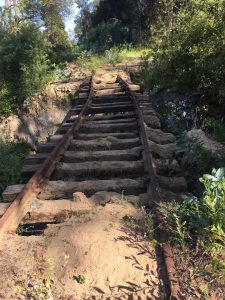
I have ridden the train from Watsonville to Santa Cruz.
In 1980 I and three other videographers had an early morning rendezvous in Watsonville with a man from the Southern Pacific Railroad. He had driven from Sacramento expecting to meet up with KSBW Channel 8; when he learned we were from Capitola Community Channel 8, his misery was tangible. Salvaging his morning, he asked our respective roles (camera, sound, engineer, and producer) and if we were armed. Satisfied, he pointed us to the caboose.
At that time Southern Pacific was the owner and operator of the Branch Line. SP’s rail network covered much of the country with some of its track rated at 80 mph and more. In contrast, the Santa Cruz Branch Line was rated “Excepted Track”, the lowest, slowest track class possible.
Under typical marine layer skies the diesel engine revved and pulled us slowly across Lee Road. I expected the train to speed up when we left the warehouse district and asked the SP worker with us in when we would start going faster. “This is it”, he said.
Our slow speed offered slow views not seen from roads. Crossing the Watsonville and Harkins Sloughs was reminiscent of the lagoons of Venice: the magical admixture of water and sky and mountain. On earth as it is in heaven.
The engine becomes louder as the slough passes and the hill rises from the Pajaro Valley. This is the steepest climb of the entire Branch Line and the engine strains, enters gradual switchbacks and into primordial-feeling eucalyptus forest. Again, something not seen from the road, the forest has a denseness and darkness and the special eucalyptus lemon mint scent, discernible even from the caboose balcony of a stinking diesel train.
The train emerges from the forest and crosses Buena Vista Road, from which point the Branch Line is visible from public roads for the rest of its route.
The top speed on Excepted Track is 10mph, and no passengers are allowed. We were given permission as putative documentarians to ride in the caboose. The Branch Line is still Excepted Track and has deteriorated below the value of scrap by some reckoning. (The short segment where the Roaring Camp train loads at the Boardwalk is maintained Class 1 Track.)
The next crossing, Spring Valley Road, is notable as the location and destination of several renditions of “The Train to Christmastown”. How the Santa Cruz County Regional Transportation Commission circumvented federal law (Code of Federal Regulation “49 CFR § 213.4 Excepted track”), which prohibits operation of occupied passenger trains on Excepted Track, is a mystery. “Unsafe at any speed” might be the tag line for your next visit to Santa by local rail.
Speaking of safety, also in “49 CFR § 213.4 Excepted track”: “No freight train shall be operated that contains more than five cars required to be placarded by the Hazardous Materials Regulations (49 CFR part 172)”. Hazardous material experts consider that “empty” tank cars are even more dangerous than full with the increased available oxygen.
There are currently nearly 100 hazardous material placarded tank cars parked in Watsonville and over the sloughs. The north coast will neither be spared, saving the RTC from charges of inequity and treating South County as a colony.
The Southern Pacific and later the Union Pacific were true railroads, moving local freight and serving local customers. By that standard, Progressive Rail is not a railroad. It is more accurately a part of the energy sector, specifically what is called a “midstream” operator. “Upstream” is where the energy oil, gas, or coal is extracted. “Downstream” is where the product reaches the users’ pilot light or gas tank. “Midstream” is everything else. Progressive operates in this space, and its arbitraged LPG tank cars are the sweet profit spot.
Awarding freight rail contracts means the loss of local and state hazardous materials oversight. Sonoma and Marin counties are already unable to control hazardous LPG cars on their tracks, even adjacent to the touted SMART passenger service. The Santa Cruz County Environmental Health Services is the local hazardous material clearing house. SCCEH have never received the required “hazardous materials business plan” from Iowa Pacific, nor do they expect one from Progressive. “We don’t have the regulatory authority to stop them,” says the hazardous material program manager Rebecca Supplee.
RTC lawyers are investing their time on contract law for the Progressive deal. They might instead direct their attention to civil and criminal penalties in the Code of Federal Regulation 49. Rail at any cost, by whatever means necessary, and unsafe at any speed, is sadly the current RTC standard operation procedure.
Meanwhile, back in 1980, the combination of slow travel (who knew it would take more the three hours to get to Santa Cruz?) and 1980 battery technology for our Sony Portapak, meant that our documentary was never produced. Still, it was a privilege to travel the route; the Branch Line is an engineering and environmental marvel. It deserves better than what the RTC plans.
Originally published in the Watsonville Register-Pajaronian, June 15, 2018
